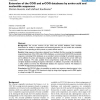BMCBI
2008
13 years 11 months ago
2008
Background: A goal of proteomics is to distinguish between states of a biological system by identifying protein expression differences. Liu et al. demonstrated a method to perform...
BMCBI
2008
13 years 11 months ago
2008
Background: Ornithine decarboxylase antizymes are proteins which negatively regulate cellular polyamine levels via their affects on polyamine synthesis and cellular uptake. In vir...
BMCBI
2008
13 years 11 months ago
2008
Background: Insertions and deletions (indels) represent a common type of sequence variations, which are less studied and pose many important biological questions. Recent research ...
BMCBI
2008
13 years 11 months ago
2008
Background: Researchers interested in analysing the expression patterns of functionally related genes usually hope to improve the accuracy of their results beyond the boundaries o...
BMCBI
2008
13 years 11 months ago
2008
Background: Evolutionary conservation of RNA secondary structure is a typical feature of many functional non-coding RNAs. Since almost all of the available methods used for predic...
BMCBI
2008
13 years 11 months ago
2008
Background: Designing small-molecule kinase inhibitors with desirable selectivity profiles is a major challenge in drug discovery. A high-throughput screen for inhibitors of a giv...
BMCBI
2008
13 years 11 months ago
2008
Background: The current versions of the COG and arCOG databases, both excellent frameworks for studies in comparative and functional genomics, do not contain the nucleotide sequen...
BMCBI
2008
13 years 11 months ago
2008
BMCBI
2008
13 years 11 months ago
2008
Background: MAGE-ML has been promoted as a standard format for describing microarray experiments and the data they produce. Two characteristics of the MAGE-ML format compromise it...
BMCBI
2008
13 years 11 months ago
2008
Background: Exonic splicing enhancers (ESEs) activate nearby splice sites and promote the inclusion (vs. exclusion) of exons in which they reside, while being a binding site for S...




